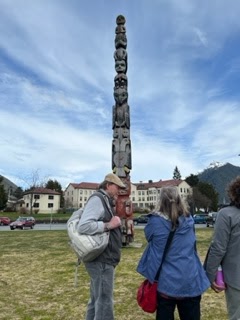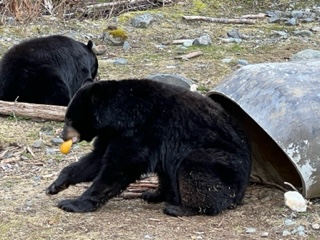When we arrived in Sitka, it was gorgeous weather. Sunny and in the 50s. Light jacket weather. The next day, still warm but a little overcast. The next cloudy and cool. Day 4 rain threatened, and our last day was cold with heavy rain, sleet, hail and brief snow. Typically in Sitka there are 14.8 days with precipitation during the month of April. So, I think we were lucky with the weather we got.
We had rented a “beater with a heater” from our AirBnB landlord for our stay. The price certainly was right, but the Ford Ranger pickup truck was definitely an older model with no extras. It took some getting used to, for sure. It was hard to get into gear, but once that was accomplished Sal drove us around at a pretty constant 25 MPH due to scary noises generated with higher speeds. We also think calling it just a “beater” is more accurate. On the last wet, cold day, the heater was nowhere to be found. But it got us where we wanted to go.
Our flight was Anchorage to Juneau then a 25 minute flight to Sitka. Our first stop was at the Visitor’s Center for information. We knew we were in the shoulder season and wanted to check days/times attractions were open. We had not realized we were arriving just days before the first cruise ship was due in. We found many things were closed in preparation for the crowds expected with the ships. We had to shuffle our plans around somewhat, but we were able to see almost everything on our list.
First we visited the Sitka National Historic Park to get a passport stamp for Sal. Nuh-uh. The Park Visitor’s Center closed for…see above. We did walk the beautiful rainforest trails in the park, which we loved, but the trails also were lined with totem poles. Not many were originals because the weather is hard on them, but a master carver is on site at the Park to repair and carve replacements.
The poles displayed are not native to Sitka. The 1904 World’s Fair was held in St. Louis to commemorate the centennial of the Louisiana Purchase. Something uniquely American was desired to be displayed. Totem poles! Alaskan Governor John Brady, traveling on the Revenue Cutter Rush, sailed around Prince of Wales Island in Southeast Alaska and collected (stole, maybe?) 15 poles from Tlingit and Haida villages. These were then erected outside the Alaska Pavilion to create a unique and distinctive appearance in hopes of attracting fair visitors. The poles were later returned to Sitka and became the foundation for the collection of poles seen today.
We chatted with some interesting folks along the trail, including one of the totem carvers and a bird watcher, who pointed out a new bird to us, (We, and, as usual, I mean Sally, are trying to become bird watchers.) We checked into our home for the next four nights, then drove around some. We ended up at Harbor Brewing, which conveniently has Campfire Pizza in the same building. Two thumbs up for each! We had started the day at 4:15am, so we headed back to reschedule our itineraries to fit in with the new hours of the various attractions.
Friday we took a great walking tour with Bob Purvis, a retired history professor at UAA. In addition to pointing out historical sites and sharing history of Sitka, we went into several shops where owners described their locally made products, such as Devil’s Club soap and salve. Devil’s Club is a powerful plant in the Alaskan forest reputed to hasten healing of a number of ailments. Also to calm itching. With our first mosquitoe season approaching, we bought a few things there and hope they live up to their claims. Alaska Pure Salt Co.’s mission was to produce North America’s first flake salt. That was a fun stop, sampling the different flavor salts and learning how the salt-making was discovered (on an anniversary get-away with a pot of water left inadvertently on the stove overnight). I love finishing salts and am already enjoying purchases made there. Everyone in the different stores was very friendly. The clerk at the bookstore was from Springfield VA. Her dad was working at the Pentagon the day of the Alaska earthquake in 1964. She remembers her dad talking about that day, how suddenly all communication with Alaska was cut off. This was during the Cold War, so no telling what the military was thinking until an Alaska woman was able to start communication by shortwave radio. Here’s another interesting story. Bob has given several tours to groups of Russians. He said they are under the impression that Russia leased Alaska to the US rather than sold it. Hmm.
We visited The Fortress of the Bear, a facility set up in an abandoned pulp mill to rescue bear cubs, bring them back to health and provide a long life full of enrichment. The state of Alaska has no bear rehabilitation program in place, and orphaned cubs are routinely shot by the Department of Fish and Game. Eight bears are permanent residents here. Alaska doesn’t allow bears to be released back into the wild. The bears here were raised from cubs. Most know some sign language. We saw a bear signing “more” just before feeding time. They know their names, and we saw one stop his play and look up when his name was called. We were fortunate that the founder of the sanctuary, Les Kinnear, was on site when we visited, and we spoke at length with him about the bears, the trials of getting the facility started and his hopes for Alaska bears. They have sent orphaned cubs to the Bronx Zoo and other bear sanctuaries, but hope laws will change so bears can be returned to the wild.
We also had a great visit at the Alaska Raptor Center. Sal had called to verify they were open; closed for cruise ship training until Monday, but open Monday. Got it. On Monday when we showed up, guess what…closed. But they were very nice and let us walk through with no charge, so we gladly made a donation. We were able to watch their eagles in the flight center through one-way glass. Eagles, as we know, can be released back to the wild so they try to limit human interaction. They have a nice facility in a lovely location along the Indian River. We were going to walk more, but a prominent bear aware sign made us head back. I had asked on a couple of our walks; yes, the bears were waking up. I didn’t want to risk running into a hangry bear. We were, again, lucky in our timing. A volunteer approached us to say she was getting ready to bring out her horned owl, did we want to see? So glad we stayed. We spoke with her and Narwhal, the owl, for 30 minutes or so, until Narwhal had had enough. We have been so lucky at many places to have the opportunity to speak one-on-one with people with various areas of expertise. We’ve learned so much!
We went to the Sheldon Jackson Museum, founded in 1888 by the Reverend Sheldon Jackson, who was Presbyterian missionary and General Agent of Education for Alaska. He features prominently in James Mitchner’s “Alaska,” which I’m currently reading. It houses a great collection of Alaska Native ethnographic material gathered by the Reverend Jackson. I had to look up “ethnographic.” It’s “relating to the scientific description of peoples and cultures and their customs, habits and mutual differences.” Yes, the museum had that, attractively displayed in a unique building, Alaska’s first concrete building.
We were not able to go into St. Michael’s Russian Cathedral, the first Orthodox Cathedral established in North America in 1848 by St. Innocent, the first bishop of Alaska. We were able to tour the Russian Bishop’s Hone, which is part of the National Park Service. It was beautiful inside, both the living quarters and the chapel, so we were able to get a sense of the icons and other religious relics that would be in the cathedral.
A quick but moving stop was the National Cemetery in Sitka. We saw soldiers graves from WWI, WWII and Vietnam. In another area were older graves from the mid-1800s with Russian names. It was interesting.
We ate well in Sitka. We visited several coffee shops for afternoon recharging, and when we walked past a young guy carrying the most delicious-looking ice cream concoction, we had to stop him and make inquiries. He was so enthusiastic about the old fashioned soda counter at Harry Race Pharmacy, we had to try it, twice, actually, for hot fudge and banana/caramel sundaes. We loved the restaurant Beak and went twice, enjoying dinners of salmon and halibut and their Sunday brunch, and we also went twice to Pel’Meni for Russian dumplings.
We got a chuckle out of this intersection.





















.jpg)

No comments:
Post a Comment